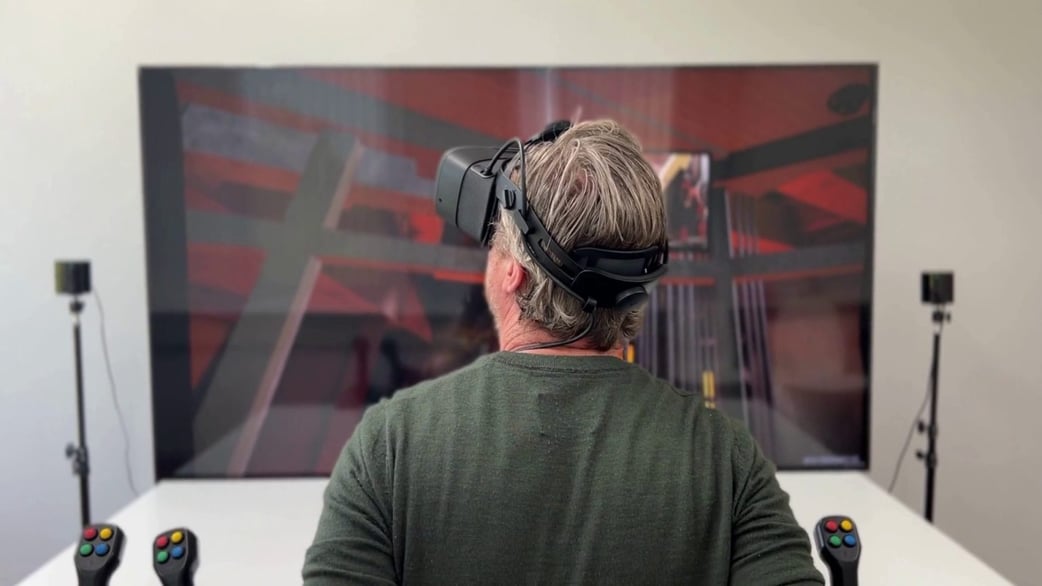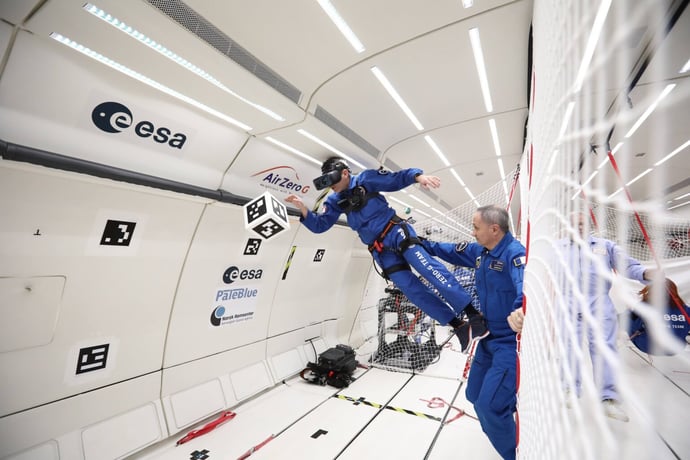The 10 essential benefits of VR crane simulator
At Steel Sim VR, we use the unmatched quality of Varjo’s head-mounted displays (HMDs) to bring this advanced simulation training to crane operators. The Steel Sim VR platform is now compatible with the Varjo XR-4 Series, enhancing the training experience even further.
What has been the standard in the aviation industry for training pilots has finally become available to other high-risk training environments. As it is now so logical to train pilots in a simulator, why not train crane operators in a simulated setting as well?
One of the reasons in the past was that the investment needed to build a training simulator could only be done in the aviation, defense or space-industry with their budget capabilities and Return on Investment potential. With the latest possibilities to bring all this simulation technology and realism into the current state of computer hardware and HMD’s by Varjo, we were able to bring this type of training technology to the steel industry.
With this article, we want to zoom in on why this type of training is relevant to crane training in the steel industry by addressing 10 essential benefits that are shaping the return on investment of our clients.
Capture footage of the Algoma Steel simulator
Transforming Steel Industry Training: Benefits and ROI of VR Crane Simulators
It’s crucial to recognize that each steel factory may have unique requirements, making the evaluation of these factors dynamic and tailored to specific needs.
This summary provides a foundational understanding, noting that the complete set of relevant factors may vary across different factories.

1. Enhanced Ease of Access
VR simulators can be set up in multiple controlled environments, making them easily accessible for training. This eliminates the need for transporting trainees to job sites, saving on waiting time and logistical issues.
2. Skill Improvement
VR simulators allow trainees to repeat scenarios and exercises as needed, fostering more confident and competent operators. This is especially useful when it comes to training for special operations, which are maneuvers that happen once every now and then. Training for special occurrences is often left aside in traditional training. Comprehensive training reduces the risk of errors and related costs.
3. Data Analytics and Monitoring
Steel Sim VR simulators offer data analytics and monitoring. Instructors can track performance, identify improvement areas, and adjust training programs accordingly. This data-driven approach optimizes learning and potentially shortens training duration.
4. Adaptation to Automated Cranes
As cranes become more automated, on-the-job training becomes less feasible. VR simulators provide a solution by allowing operators to train on simulated automated cranes, ensuring they are well-prepared for when they need to step in. Simulated training also helps keep operators up to date with the latest technological advancements in crane operation.
 Capture footage of the ArcelorMittal Eisenhuttenstadt simulator
Capture footage of the ArcelorMittal Eisenhuttenstadt simulator
Plant and personnel benefits
5. Enhanced Safety
VR crane simulators offer a risk-free environment for trainees, allowing them to learn without the dangers of operating heavy machinery. This reduces accidents, injuries, and equipment damage, leading to lower associated costs.
6. Lower Equipment Maintenance Costs
Using actual equipment for training causes wear and tear. VR simulators let trainees practice without stressing real cranes, reducing maintenance and repair expenses.
 Capture footage of the Arcelormittal Gent simulator
Capture footage of the Arcelormittal Gent simulator
Operational benefits
7. Reduced Training Time
On-the-job training can be slow due to job site conditions and production schedules. VR simulators offer flexibility, enabling trainees to practice anytime and accelerating the learning process. Clients of Steel Sim VR have reported up to a 60% reduction in training time.
8. Operational Cost Savings
Operating heavy machinery incurs fuel and operational costs. VR simulators eliminate fuel needs and reduce expenses related to running real equipment, making training more economical.
9. Improved Operational Efficiency
VR training allows operators to practice complex maneuvers and load handling virtually. This leads to faster and more precise crane movements, enhancing overall task completion times.
10. Decreased Downtime
Training on live equipment can lead to downtime due to unexpected incidents. VR training addresses common mistakes virtually, resulting in fewer errors and less downtime, ensuring smoother workflows in steel manufacturing.
Unlocking new heights in crane operator training through VR
Ultimately, the return on investment for VR crane simulators is substantial, offering a comprehensive solution that enhances skills, reduces risks, and drives operational excellence. The data-driven insights from VR training further refine and optimize training programs, making them more effective and tailored to the unique needs of each steel plant. As the steel industry continues to evolve, embracing such innovative training methods will be crucial for maintaining competitive advantage and ensuring the highest standards of safety and efficiency.
For more details on how Steel Sim VR can elevate your crane training program, please contact us.


